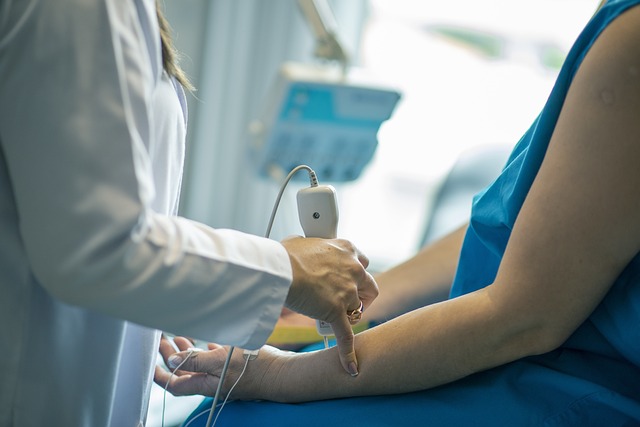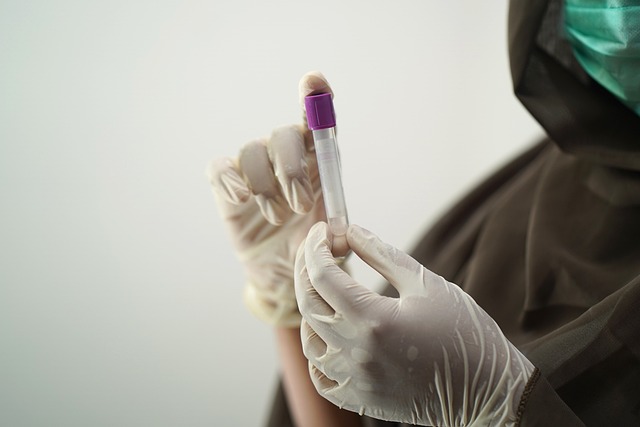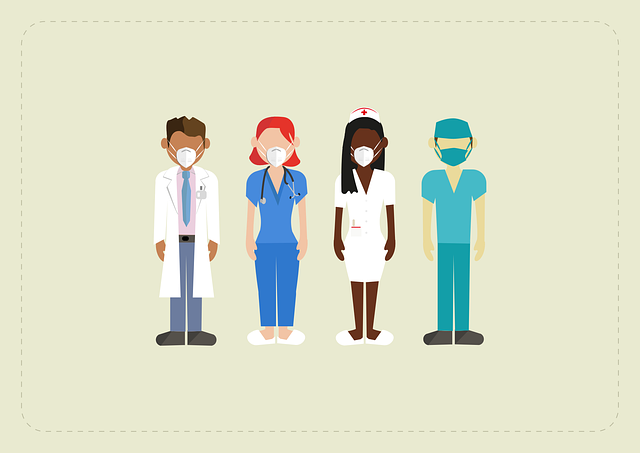In the UK, translating patient medical records requires strict adherence to General Data Protection Regulation (GDPR) guidelines to protect sensitive personal data. Translation services for Patient Medical Records UK must secure explicit patient consent, implement robust security protocols during translation, and ensure secure storage of documents accessible only to authorized personnel. Reputable services that comply with GDPR are vital for healthcare providers to maintain compliance while effectively managing multilingual records. Non-compliance can lead to severe legal implications, data breaches, and potential bias in treatment decisions. Healthcare organizations should prioritize professional translators with medical expertise, conduct translations under secure conditions, and implement robust encryption for stored data. Advanced technologies like machine learning and AI, along with localization and cultural adaptability, are shaping the future of GDPR-compliant medical translation services in the UK.
Are your translated patient records GDPR-compliant? In today’s global healthcare landscape, ensuring data privacy and accuracy across borders is paramount. This comprehensive guide explores the intricate balance of translation services and GDPR (General Data Protection Regulation) compliance in the UK. We delve into the legal framework governing patient records, best practices for translators, and case studies demonstrating successful implementations. Discover how technology enhances compliance and learn strategies to build trust with patients through transparent translation processes, ensuring your medical translations meet stringent GDPR standards.
- Understanding GDPR and Patient Records in the UK
- The Importance of Translation Services for Medical Accuracy
- GDPR Compliance: A Comprehensive Checklist for Translators
- Legal Implications of Non-Compliant Translated Medical Records
- Best Practices for Ensuring Data Privacy During Translation
- Case Studies: Successful GDPR-Compliant Translations in Healthcare
- Common Pitfalls to Avoid When Translating Patient Records
- The Role of Technology in Enhancing GDPR Compliance
- Building Trust with Patients: Transparent Translation Processes
- Future Trends in GDPR-Compliant Medical Translation Services
Understanding GDPR and Patient Records in the UK

In the UK, the General Data Protection Regulation (GDPR) sets stringent standards for protecting sensitive personal data, including patient records. This regulation has far-reaching implications, especially in the healthcare sector, where the confidentiality and security of medical information are paramount. When dealing with translated patient records, ensuring GDPR compliance becomes even more complex due to the involvement of third-party translation services.
Translation services for Patient Medical Records UK must adhere to these regulations to prevent data breaches and maintain patient privacy. This involves obtaining explicit consent from patients for their records to be translated and shared, implementing robust security measures during the translation process, and ensuring that all translated documents are stored securely and accessed only by authorised personnel. Choosing a reputable translation service that understands and abides by GDPR guidelines is crucial for healthcare providers to remain compliant while effectively managing patient records in a multilingual setting.
The Importance of Translation Services for Medical Accuracy

In the UK, ensuring patient medical records are accurate and compliant with data protection regulations like GDPR is paramount. When dealing with multilingual patients, translation services play a critical role in maintaining this accuracy. Professional translators with medical expertise must handle these records to prevent any loss or misinterpretation of vital information during the translation process.
Translation services for patient medical records UK-wide must adhere to strict standards to safeguard patient confidentiality and data integrity. This includes employing secure translation methods, ensuring translators are trained in medical terminology, and following GDPR guidelines to protect sensitive health information. Such services are essential to facilitating seamless communication across diverse linguistic backgrounds while preserving the quality and legality of healthcare documentation.
GDPR Compliance: A Comprehensive Checklist for Translators

When providing translation services for patient medical records in the UK, ensuring GDPR compliance is non-negotiable. Translators must adhere to strict data protection regulations to safeguard sensitive patient information. A comprehensive checklist should include verifying that all translated documents meet privacy standards, such as obtaining necessary consents and anonymising data where applicable.
Additionally, it’s crucial to establish secure data transfer methods, implement robust access controls, and maintain detailed records of translation processes and personnel involved. Regular reviews of compliance procedures and staying updated with evolving GDPR regulations are essential practices for translators working with patient records to prevent any legal or ethical complications.
Legal Implications of Non-Compliant Translated Medical Records

The legal implications of non-GDPR compliant translated medical records can be severe. In the UK, the General Data Protection Regulation (GDPR) sets strict standards for handling personal data, including patient records. When translation services are involved, it’s crucial that the translators not only provide accurate translations but also ensure the resulting records meet these regulations. Failure to comply can result in hefty fines and legal repercussions, as well as damage to a healthcare provider’s reputation.
Non-compliant translated medical records can pose significant risks. These may include breaches of patient privacy, unauthorized data sharing, and potential discrimination or bias in treatment decisions based on the language of the record. Healthcare providers using translation services for patient medical records UK must verify that their chosen translators are aware of and adhere to GDPR guidelines. This includes implementing robust data security measures, obtaining explicit consent from patients, and ensuring transparency throughout the translation process.
Best Practices for Ensuring Data Privacy During Translation

When utilizing translation services for patient medical records in the UK, data privacy must be a top priority to ensure GDPR compliance. Best practices involve employing professional translators who are familiar with medical terminology and data protection regulations. All translations should be conducted under secure conditions, with access restricted only to authorized personnel.
Additionally, implementing robust encryption protocols for stored data and ensuring that translation workflows adhere to strict confidentiality agreements is essential. Regular audits and updates of security measures should be performed to address emerging threats and maintain compliance with GDPR requirements. This comprehensive approach safeguards patient privacy while facilitating accurate and legally sound translations of medical records.
Case Studies: Successful GDPR-Compliant Translations in Healthcare

In recent years, numerous healthcare organizations have successfully navigated the complex landscape of GDPR compliance through strategic utilization of translation services for patient medical records UK. These case studies demonstrate that accurate and secure translations can be achieved while adhering to stringent data protection regulations. For instance, a leading hospital network in London implemented a robust translation system that ensured all patient records from diverse linguistic backgrounds were handled with utmost confidentiality. By employing native-speaking translators with specialized medical expertise, they maintained data integrity and privacy throughout the translation process.
Another inspiring example involves a regional healthcare authority that collaborated with a reputable translation company to translate patient records into several European languages for an international study. The project required meticulous attention to cultural nuances and local legal requirements. Through comprehensive quality assurance protocols and ongoing communication with medical professionals, the translated documents not only met GDPR standards but also facilitated smooth data exchange between participating countries, showcasing the critical role of professional translation services in global healthcare initiatives.
Common Pitfalls to Avoid When Translating Patient Records

When translating patient records, healthcare providers must be vigilant to avoid common pitfalls that can compromise data privacy and GDPR compliance. One significant issue is the potential for human error during translation, which can introduce inaccuracies or misinterpretations of medical terms, leading to incomplete or incorrect record-keeping. This is especially critical in the UK, where strict regulations require the preservation of patient confidentiality.
Another trap to avoid is relying solely on machine translation tools without human oversight. While these technologies have advanced significantly, they may not capture nuances in medical language or cultural context, potentially leading to errors that could impact patient care and legal liability. Using professional translation services specializing in Patient Medical Records UK ensures that skilled linguists with healthcare expertise handle the task, minimizing risks associated with non-compliance.
The Role of Technology in Enhancing GDPR Compliance

In today’s digital era, healthcare organizations rely heavily on accurate and timely translation services for patient medical records, especially when catering to a diverse patient base across the UK. This is where technology plays a pivotal role in enhancing GDPR (General Data Protection Regulation) compliance. Advanced translation tools equipped with machine learning algorithms can ensure that patient data is handled with the utmost security and confidentiality. These technologies employ encryption methods, secure storage solutions, and sophisticated access controls, thereby adhering to the stringent requirements of the GDPR.
Moreover, technology enables efficient tracking and management of translated records. Digital platforms allow for easy retrieval, updates, and sharing of patient information while maintaining a comprehensive audit trail. This transparency is crucial for compliance purposes, enabling healthcare providers to demonstrate adherence to data protection regulations. By leveraging the capabilities of translation services that prioritize security and efficiency, medical practices can ensure their patient records are GDPR-compliant, fostering trust among their diverse patient population in the UK.
Building Trust with Patients: Transparent Translation Processes

In today’s global healthcare landscape, ensuring patient records are accurately and transparently translated is crucial. When it comes to translating sensitive medical documents, such as patient records, it’s essential to uphold the highest standards of privacy and security. This includes adhering to regulations like GDPR (General Data Protection Regulation) in the UK, which safeguards patients’ rights and gives them control over their personal data.
Translation services for Patient Medical Records UK must be designed with transparency at every step. Patients should be clearly informed when, why, and how their records are being translated. Providing detailed information on the translation process builds trust between healthcare providers and patients, ensuring they feel secure in sharing their sensitive medical information. Transparent practices also enable patients to make informed decisions about their data usage, fostering a positive relationship based on honesty and clarity.
Future Trends in GDPR-Compliant Medical Translation Services

The future of GDPR-compliant medical translation services in the UK looks set to be shaped by several key trends. One prominent development is the increasing adoption of advanced technologies, such as machine learning and artificial intelligence (AI), which can streamline and enhance the accuracy of translations. These tools can analyse vast amounts of medical data, including patient records, to provide more precise and contextually relevant translations. This not only improves efficiency but also ensures that critical information is conveyed accurately across languages.
Another notable trend is the growing emphasis on localisation and cultural adaptability. Medical translation services will need to go beyond simple word-for-word interpretations and embrace the nuances of different languages and healthcare systems. This involves understanding local regulatory requirements, cultural contexts, and even dialectal variations to deliver translations that are not only legally sound but also easily comprehensible for patients and healthcare professionals alike. As the UK continues to engage with global health initiatives, translation services must evolve to meet these demands, ensuring that patient records remain secure, accurate, and GDPR-compliant across borders.
In ensuring patient data privacy and compliance with GDPR regulations, translation services for patient medical records in the UK play a vital role. By adhering to best practices, leveraging technology, and maintaining transparency throughout the translation process, healthcare providers can confidently navigate the complexities of international data transfer while safeguarding sensitive information. This comprehensive guide highlights the importance of thorough preparation, meticulous attention to detail, and ongoing adaptation to evolving standards in the field of medical translation, ultimately fostering trust with patients and promoting secure data management.



